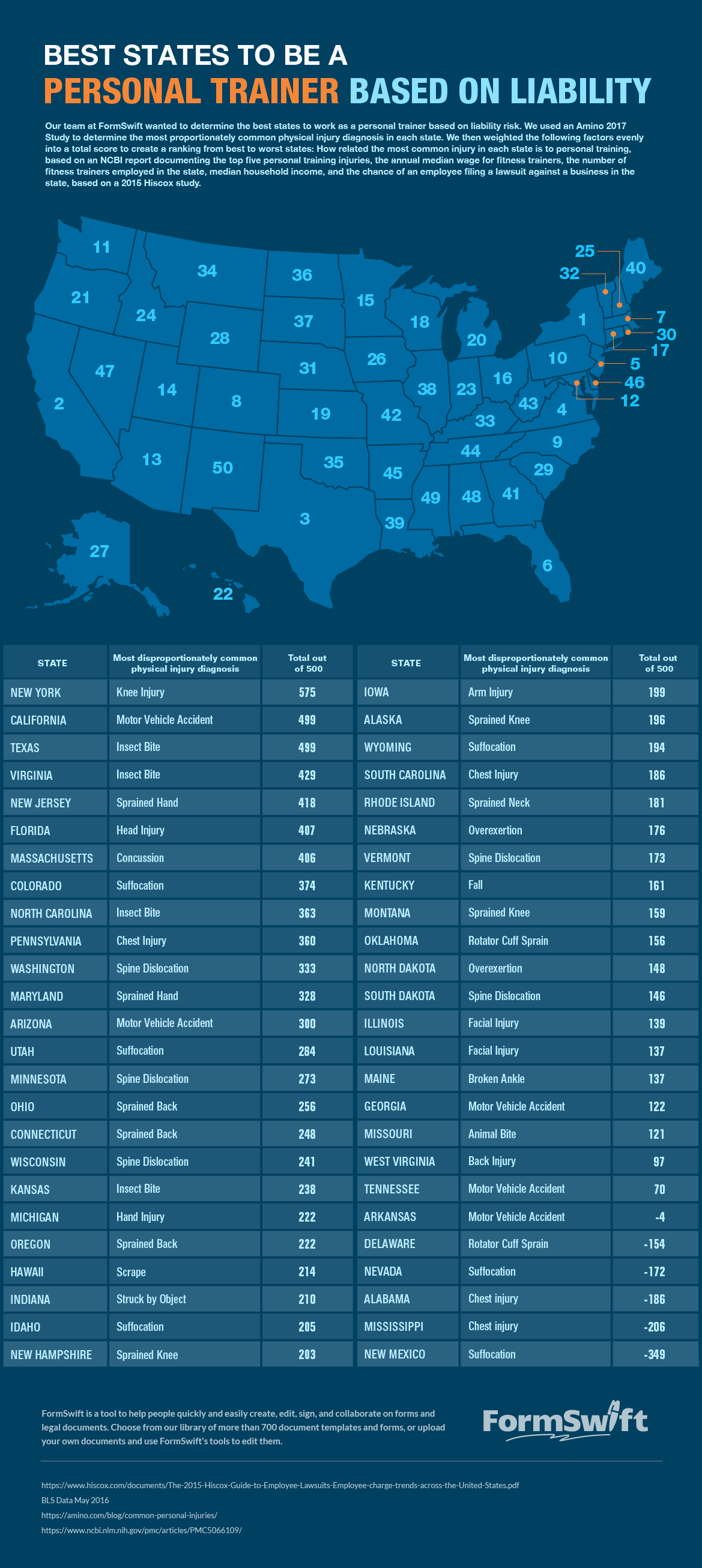Waiver Forms for Personal Training Form
Waiver forms for personal training are used to protect a trainer from liability in the unfortunate case that a client is injured while training. These forms must typically be completed by the client before training services are rendered. Personal training waiver forms are typically basic and only require standard information from the client such as their name, date, and signature. Personal training waiver forms can last for a set number of sessions or can be effective indefinitely.
Table of Contents
What are Waiver Forms for Personal Training?
Ultimate Guide to Waivers for Personal Training
Best States to be a Personal Trainer Based on Liability
Related Documents
What are Waiver Forms for Personal Training?
Personal training waiver forms are used by personal trainers working with individual clients. This form will be used to protect the personal trainer from liability in case a client is injured or suffers financial or physical damages during their interaction with the fitness trainer. This form typically must be completed before the client begins sessions with the trainer, whether they are held at the client's home, the trainer's home, or a fitness center or gym.
These forms are typically basic, and the client will only need to include some information, such as their name, the date they will start their training, and the date they are completing the form. A trainer can have a single standard form available with the same information for all their different clients. This form must be signed and dated by the client in order for it to be legally binding. It can have an expiration date, such as one year or for 8 sessions, or it can persist indefinitely.

Create a Waiver Forms for Personal Training in minutes with our professional document builder.
Ultimate Guide to Waivers for Personal Training
By FormSwift Editorial Team
June 11, 2018
Introduction
According to the CDC, each day more than 10,000 people receive treatment for sports and exercise-related injury. Seniors, in particular, account for more than 53,000 these injuries each year. Given the ubiquity of personal injury, it is imperative that personal trainers protect themselves against unforeseen legal repercussion. Requiring your clients sign a specialized waiver form when they utilize your personal training services is one way to do so. This guide, therefore, covers why trainers need a waiver, how to create one, and what sorts of insurance policies gym owners should consider purchasing.
Common mistakes personal trainers make regarding liability
Many trainers believe the notion that because their clients are signing a liability waiver or release form, they are automatically protected from any liability. This, however, is false. There are a number of ways in which personal trainers fail to properly safeguard themselves from legal action. The most common of those include:
- Insufficient certifications: proper professional certification will provide you with a scientifically-informed and legally-protected foundation from which to train clients and cite, in the event of a lawsuit. Proper certification, in other words, helps shield you from legal liability.
- Insufficient liability insurance
- Insufficient documentation of clients’ pre-existing medical and injury history: proper documentation of pre-existing injuries will help protect you from charges your training sessions caused them.
- How to document a client’s medical history: ask them the following:
- Have you ever had heart trouble? Do you ever have pains in your heart or chest?
- Does your family have a history of heart attack or stroke?
- When was your last physical examination by a doctor?
- What is your exercise history or exercise experience?
- Do you ever faint or have dizzy spells?
- Has a doctor ever diagnosed you as having high or abnormal blood pressure?
- Do you have bone or joint programs?
- Are there any physical reasons why you should not complete a training program?
- If your client answers 'yes' to this question or other medical questions, be sure that they have received medical clearance to participate in training. Also, do not take their word for it. Be sure you have a copy of their physician release form. Weight loss, strength training, and other physical activity put stress on the body. You do not want to put your client in harm's way by putting them through a program where the exercise level is past what is healthy for their body; which can place you in legal jeopardy.
- Nutritional advice: do not give nutritional advice unless you are certified to do so. If you are not, it is best to refer a client to a professional, if they request nutritional guidance.
Why clients sue their trainers
Here are the most common reasons why clients sue their trainers:
- They received improper instruction that led to injury or undesired results.
- Be sure, therefore, to always establish expectations for training--for both you and your client--and always offer instruction of proper exercise form and use of exercise equipment. Even if a client claims to be an experienced gym connoisseur, a fitness assessment will give you insight into their exercise form and posture.
- An exercise machine malfunctioned, causing injury
- Improper supervision during training that led to injury
- Improper nutritional advice that led to harm.
- Failure to communicate the injury or health risks associated with the training program.
- The trainer pushes the client too hard, resulting in injury.
Legal risks of fitness centers
Gyms and other exercise centers face legal risk in three areas:
- Injury: even if you require patrons to sign a waiver, you may still be responsible for certain injuries that occur on the premises.
- Equipment: you may be liable if your equipment is not in proper working order and someone is subsequently injured.
- Trainers: trainers can help minimize liabilities by helping members of your fitness center understand how to use fitness equipment properly.
Gym Insurance
Gym insurance is a good idea, and may even be required. Your insurance needs vary depending on the size and scope of your gym.
Here is a rundown of common insurance policies for fitness centers:
- Gym liability insurance covers the following:
- General liability (bodily injury and property damage)
- Professional liability (covers errors and omissions risks of staff members)
- Product liability (covers risks related to workout equipment and nutritional products)
- Employee liability (covers you if you are accused of poor practices, sexual harassment or discrimination by employees).
- Property coverage (covers damage to your business’ property)
- Equipment coverage (covers the breakdown of equipment)
- Workers compensation (covers work-related injuries or illnesses incurred by employees while on the job)
Here are some additional types of liability insurance that may be necessary, depending on your needs:
- Participant liability and accidental medical coverage -- covers you if participants in a class (like boxing) are injured in a competition/tournament sponsored by your business
- Spectator liability coverage -- covers you if a spectator is injured during a competition/tournament sponsored by your business
- Supplemental liability insurance -- covers you if your business offers other services like tanning beds, swimming pools, massage, spa/skincare, etc.
- Umbrella liability -- covers you if something happens that results in a large liability lawsuit and other liability policies are exhausted.
Many personal trainers operate small fitness centers and therefore may want to have a business owner’s policy for their business (BOP). A BOP covers general liability insurance, property insurance, loss of business income coverage--if you are shut down for a period of time, this will insure you during the closure for income.
Protecting your business
Ultimately, if you own a fitness center, you should do what is necessary to protect your business. This includes:
- Insurance (as mentioned above)
- Use of a waiver or training participant release
- Such waivers inform clients of the risks associated with participating in personal training and relinquishes their ability to sue you for negligence.
- When creating your waiver, require clients to initial each paragraph. This ensures they are aware of all risks.
- Ask clients to ask questions about anything in the document.
- Make sure the waiver complies with all state laws
- If constructed properly, a waiver can save you from court.
Conclusion
Personal training waivers are an essential component of the exercise profession. They ensure clients are aware of the risks of their exercise program and that trainers are legally protected in the event of injury. We hope this guide provides you with all the information you need to operate your gym or work as a trainer in a more informed and transparent fashion.
Best States to be a Personal Trainer Based on Liability
June 11, 2018

Methodology
Our team at FormSwift wanted to determine the best states to work as a personal trainer based on liability risk. We used an Amino 2017 Study to determine the most proportionately common physical injury diagnosis in each state. We then weighted the following factors evenly into a total score to create a ranking from best to worst states: How related the most common injury in each state is to personal training, based on an NCBI report documenting the top five personal training injuries, the annual median wage for fitness trainers, the number of fitness trainers employed in the state, median household income, and the chance of an employee filing a lawsuit against a business in the state, based on a 2015 Hiscox study.



